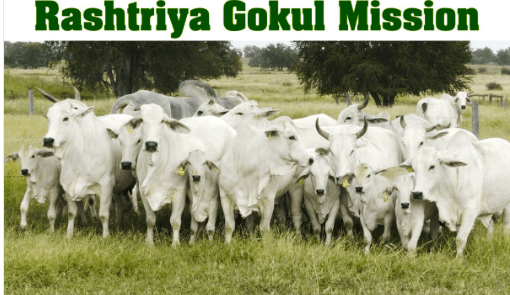The Rashtriya Gokul Mission was launched in December 2014 as an initiative to develop and conserve the indigenous bovine breeds for improving the milk production and productivity in a scientific manner which includes superior nutrition and farm management. PM Narendra Modi along with the Ministry of Agriculture & Farmers Welfare announced the implementation of the Rashtriya Gokul Mission. This mission was launched under the National Programme for Bovine Breeding and Dairy Development during the 12th Five Year Plan.

Rashtriya Gokul Mission is an important topic for the IAS Exam. Candidates can also download the notes PDF at the end of this article.
Objectives of Rashtriya Gokul Mission
The Rashtriya Gokul Mission was implemented with the following objectives:
- To develop and conserve the indigenous breeds.
- To initiate a breed improvement programme for improving the genetic makeup.
- To improve and increase milk production and productivity.
- Use of elite indigenous breeds like Gir, Sahiwal, Rathi, Deoni, Tharparkar, Red Sindhi for upgrading nondescript cattle.
- To distribute disease free high genetic merit bulls for natural service.
Government schemes are an important part of the UPSC syllabus. Aspirants must be thorough with the objectives and the activities of these major schemes for the IAS exam.
| Aspirants should begin their preparation by solving UPSC Previous Year Question Papers now!!
To complement your preparation for the upcoming exam, check the following links: |
Initiatives under Rashtriya Gokul Mission
Several initiatives were taken under the Rashtriya Gokul Mission for the conservation and development of the indigenous bovine breeds. Some of the major initiatives taken by the Government of India during the implementation of this mission are mentioned below:
- Various cattle development centres were established to develop indigenous breeds. These development centres were known as Gokul Grams.
- Initiating different awards for the farmers to encourage them to rear these indigenous breeds. Gopal Ratna award was given to the farmers for best management and maintenance of the Indigenous Breed while the Kamdhenu award was given for best managed Indigenous herd by Institutions/Trusts/ NGOs/ Gaushalas or best-managed Breeders’ societies.
- Establishment of National Kamdhenu Breeding Centre (NKBC) as a centre of excellence for the development and conservation of indigenous breeds in a scientific way.
- Developing an e-market portal for connecting the breeders and farmers. This e-market portal was named as ‘E-Pashu Haat – Nakul Prajnan Bazaar’.
- An animal wellness program, Pashu Sanjivani, was established that encompassed the provision of animal health cards.
- Use of advanced reproductive technology for a disease-free female bovine. This technology included In-vitro Fertilization (IVF) and Multiple Ovulation Embryo Transfer (MOET).
- Establishment of National Bovine Genomic Center for Indigenous Breeds (NBGC-IB).
PM recently inaugurated the following under Rashtriya Gokul Mission:
- Semen Station with state-of-the-art facilities in Purnea, Bihar.
- IVF lab established at Animal Sciences University, Patna.
- Sex sorted semen in artificial insemination by Baroni Milk Union in Begusarai district of Bihar.
Aspirants can go through the following links relevant to prepare for the upcoming UPSC examination-
What is a Gokul Gram?
India houses 14.5% of the world cattle population, out of which 83% of the population is indigenous. The Rashtriya Gokul Mission, which was implemented by the State Implementing Agency (SIA), focuses on the development of integrated indigenous cattle centres. These cattle centres are known as Gokul Grams.
A Gokul Gram mainly focuses on the following objectives:
- Promoting indigenous cattle rearing and their conservation in a scientific manner.
- Use of indigenous breeds for propagating high genetic merit bulls.
- Developing modern farm management practices, along with promoting common resource management.
- To utilize animal waste in an economical way.
Candidates should follow the latest developments in Current Affairs related to other government schemes for their UPSC 2022 preparation.
Rashtriya Gokul Mission (UPSC Notes):- Download PDF Here
Related links:
| Pradhan Mantri Kisan Maan-Dhan Yojana | UPSC Syllabus | Current Affairs |
| UPSC Notes | Topic-Wise GS 2 Questions for UPSC Mains | UJALA Scheme |
| Startup India | UDAY | Standup India |
Comments